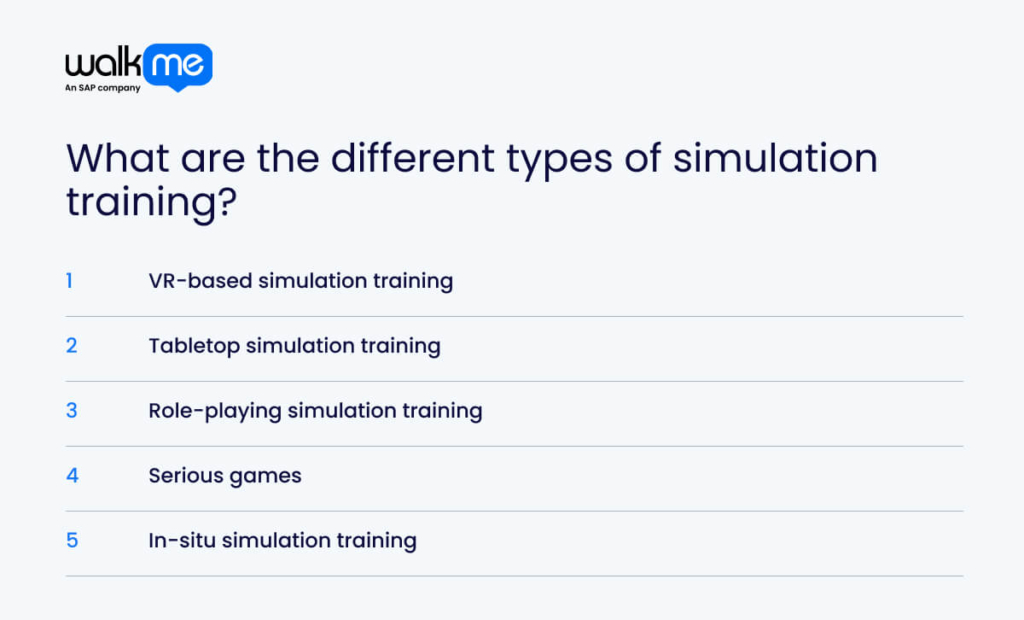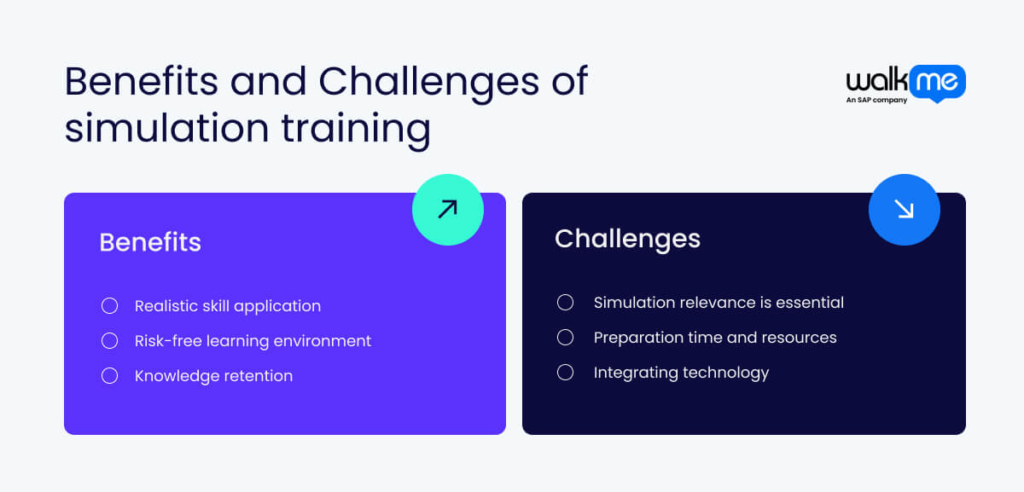Simulation training is a type of employee training that helps employees handle high-risk tasks, difficult conversations, and complex situations.
Even simple role-playing exercises and interactive games can be valuable training methods. Any business can apply these methods to build skills and prepare employees for real-world challenges.
This type of training lets employees practice different situations in a safe setting. It helps them make better decisions, solve problems, and gain confidence. Whether for leadership, customer experience, or crisis response, it provides hands-on learning without real risks.
This article explores how simulation training works, with definitions, real-life examples, benefits, and challenges.
What is simulation training?
Simulation training recreates real-world situations in a controlled environment, helping individuals build skills and decision-making abilities.
It provides a safe space for hands-on learning, where employees can practice in challenging or high-risk scenarios. This type of training can be delivered through software, experimental learning like role-play, or case studies, often combining multiple methods.
It’s widely used across all levels of an organization, from new hires to senior leaders. While valuable in many industries, simulation training has significantly impacted high-risk fields like healthcare, defense, and aviation, where realistic practice is crucial to safety and success.
What are the different types of simulation training?

Simulation training comes in various formats, such as in situ, VR, tabletop, role-playing, and serious games. These methods can be combined to enhance training outcomes.
While applicable across industries, simulation training is especially valuable in high-pressure situations. Employees benefit at all levels, from building confidence in entry-level staff to tackling complex challenges for leadership.
Now, let’s take a closer look at the five main types of simulation training:
- VR-based simulation training
- Tabletop simulation training
- Role-playing simulation training
- Serious games
- In-situ simulation training
VR-based simulation training
VR simulation training involves using virtual reality (VR) technology to create immersive, computer-generated environments for training and educational purposes.
Participants wear VR headsets or head-mounted displays (HMDs) that transport them to realistic, three-dimensional scenarios. In these virtual environments, participants can interact with objects, simulate tasks, and make decisions as if they were in the actual physical setting.
How to implement VR simulation training
VR simulation training can be costly, so the implementation process needs to be handled carefully. Assuming that you already know your training needs, think about the following steps:
- Brainstorm how VR training can meet your needs. Why is VR the best option? What hardware and software will bring the scenario to life for your employees?
- Identify a training partner. Most companies lack the internal capacity to build the right solution.
- Keep it going. As with any new training method, embedding VR takes time. After the initial setup, it can become a long-term tool in your training portfolio.
Tips for using VR simulation training
When you’re trying to implement VR simulation training in your organization, take the following tips on board:
- Simulate real-world scenarios: VR helps employees practice tasks without real consequences, building confidence and skill.
- Cut training costs: VR eliminates travel and equipment expenses, making training more affordable.
- Enable repeated practice: Employees can redo training sessions to improve and retain skills.
Who is it for?
VR-based simulation training is suitable for employees across all levels, from entry-level to senior management. It benefits industries dealing with high-risk tasks like healthcare, aviation, and defense. This training helps individuals develop practical skills, improve decision-making, and enhance problem-solving abilities in a safe, immersive environment.
Tabletop simulation training
Tabletop simulation training involves discussion and problem-solving around a table without physical movement or immersive tech. Key stakeholders or decision-makers engage in facilitated discussions of complex, work-relevant scenarios. This method is commonly used in emergency management, crisis response, and business continuity planning.
How to implement tabletop simulation training
Tabletop simulations can be a very low-tech training solution. That means that they are highly adaptable and suitable for the highly specific demands of particular organizations.
When you’re designing a multi-party tabletop exercise, consider using these milestones:
- Start by bringing together key stakeholders for an initial planning meeting. In this meeting, you’ll develop the scenario, set goals, and determine who needs involvement. Getting this right will make future steps easier.
- In a follow-up meeting, discuss who will staff the exercise and how to invite participants. Assign roles like facilitators, evaluators, and observers, and make sure everyone provides input.
- Finally, in the last meeting, confirm all the exercise details and ensure all the administrative tasks are completed.
Tips for using tabletop simulation training
Here are some further tips for tabletop simulations:
- Streamline administrative processes: Ensure invitations, confirmations, and logistics are handled smoothly for a successful tabletop simulation.
- Create a facilitator handbook: A clear guide helps leaders run simulations effectively, even if it’s a brief document.
- Be ready for feedback: Tabletop games thrive on group input, so be prepared to listen and respond to various perspectives.
Who is it for?
Tabletop simulation training is for employees in decision-making roles, such as managers or team leaders. It’s useful for emergency management, crisis response, and business continuity planning (BCP). Participants work together to solve problems through discussion, making it ideal for improving problem-solving, communication, and strategic thinking in real-world scenarios.
Role-playing simulation training
Role-playing simulations involve participants acting out specific roles in made-up scenarios that reflect real-life situations. This type of training helps improve communication, decision-making, and teamwork skills.
It can be done in different ways, from small one-on-one exercises to larger group activities, and can be the main focus of a training session.
How to implement a role-playing simulation
Here are some steps for successfully implementing role-playing simulation:
- At the start of the process, the trainer can take control of every feature of the simulation. They choose an important scenario, identify its roles, and provide the most relevant background information about each party.
- Once trainers have devised their scenarios, they should prepare to share this information with relevant stakeholders.
- Before implementing the role-play, fully prepare all learning materials. Ensure participants have the right materials and are ready to meet the challenges.
Tips for using role-play simulation training
It can take years of experience to deliver great role-play simulations. If you’re trying to improve your interventions, think about the following ideas:
- Make roleplay relevant: Link scenarios to real work situations to help employees engage and perform better.
- Schedule wisely: Ensure participants are well-rested and focused to get the most out of the roleplay.
- Embrace uncertainty: Avoid over-planning; allow for ambiguity to mirror real-life challenges employees face.
Who is it for?
Role-playing simulation training is for employees who need to improve communication, problem-solving, and decision-making skills. It’s great for situations where interpersonal skills are key, such as customer service, management, or negotiation. Participants act out scenarios to practice handling different situations, helping them learn how to respond effectively.
Serious games
Serious games are interactive and engaging computer or video games designed with a primary purpose beyond pure entertainment. These games are created to educate, inform, and train staff in real-world scenarios.
How to implement serious games
Here are some steps you should take to implement serious games in your organization:
- Implementing serious games requires the standard routine of preparation – a needs assessment, training, and evaluation.
- Remember that external partners with expertise in gaming and business deliver the most serious games. Implementing serious games will involve vendor acquisition and management.
- As a result, the best serious game implementations happen over time through strong relationships between businesses and 3rd party providers.
Tips for training with serious games
When serious games work, they’re great, but it’s important to consider the specific contexts in which they perform well.
Here are some tips for serious training games.
- Boost engagement: Serious games can help motivate disengaged employees, whether working solo or in teams.
- Choose carefully: Serious games work best for general skills training, not specialized industry knowledge.
- Enhance learning through fun: Games create an interactive learning environment, making training more enjoyable and memorable.
Who is it for?
Serious games are for employees looking to learn through interactive, game-like experiences. These games focus on developing decision-making, teamwork, and critical thinking skills. They are used in training programs across various industries, offering a fun way to practice real-world scenarios while engaging participants in a hands-on learning process.
In-situ simulation training
In-situ simulation training involves practicing simulated scenarios in the work environment, providing realistic, hands-on learning.
This approach, commonly used in healthcare settings like hospitals, enhances skills in the same context where they’ll be applied, making it effective across industries where practical learning is essential.
How to implement in situ simulation training
In-situ training is valuable in high-pressure, location-specific environments like customer service, manufacturing, and crisis management.
It’s especially effective in healthcare, offering lessons that businesses across industries can apply to improve skills and decision-making under pressure.
You can implement an “in situ” simulation exercise with these actions.
- Identify a specific situation with a training need, such as poor awareness of facilities, weaknesses in procedures, or misunderstandings about quality assurance.
- Design an “in situ” intervention to address the need, planned for a specific time frame.
- Communicate the opportunity to staff, making sign-ups mandatory if necessary.
- After the simulation, reflect, evaluate, and record the outcomes.
Tips for using in situ simulation training
In situ simulations require a great deal of careful planning—perhaps more than any of the others we’ve mentioned here.
Here are some tips for using in situ training.
- Apply learning on the job: Let employees use new skills in real work situations for better relevance.
- Provide coaching: Offer feedback during training to guide improvement.
- Encourage reflection: Give time for employees to review their performance and reinforce learning.
Who is it for?
In-situ simulation training is for employees to learn in their actual work environment. It involves real-life scenarios, allowing participants to practice skills and decision-making on-site. This training is useful for industries like healthcare or emergency response, where practicing in the actual setting helps workers prepare for real-world situations.
The business applications of simulation training
In this section, we’ll explore some of the key applications where simulation training excels.
This method is highly effective for improving skills and decision-making in various business situations, providing a safe environment to tackle real-world challenges and enhance team performance.
Project management
Training simulation is useful for the high-stakes business practice of project management.
Even experienced project managers have to adapt to the parameters of new projects, including timescale, budget, outcomes, staffing, and stakeholder priorities. These variables will also vary dramatically depending on the project’s nature.
Simulation-based training can help in various ways. For a home-grown solution, the planning cycle of tabletop simulation could help every stakeholder represent their needs in a particular scenario. For more generic training purposes, technology like MIT’s project management flight simulator can provide a ready-made training solution.
Negotiation
Furthermore, simulation training facilitates the development of crucial negotiation skills, such as active listening, effective communication, problem-solving, and adaptability. Role-playing is one of the most effective ways to practice these skills while balancing all the difficult information.
You can write your own negotiation scenarios for simulation exercises.
Remember, there are a lot of simulation exercises out there, such as those held at Harvard’s Teaching Negotiation Resource Center. For trainers going deeper, you can investigate research into the role of simulation in negotiation, as Kesting and Smolinski outline here.
Change management
Change management projects are difficult to get right, but different change training can hugely impact the overall project. Simulation training plays an important role in change management in several ways.
VR simulations can help managers practice handling difficult conversations across diverse teams or sites. Tabletop simulations allow teams to build their skills and plan for potential challenges. Meanwhile, serious games offer employees at all levels a chance to prepare for future difficulties.
Decision making
What is the best method of teaching decision-making? Many people would say “making mistakes”. Simulation training offers a safe alternative if you don’t have the time or resources to let your staff mess up in real life. Staff have opportunities to make a decision, get it wrong, and review the impact of their decision – without any negative outcomes for the business.
Decision-making is common to all the different types of simulation training. The specific nature of your decision-making issues will indicate the right course of training materials.

What are the benefits of simulation training?
As we have seen so far, simulation training offers a unique perspective on training needs. From the many benefits of this method, there are three distinctive positive features.
Realistic skill application
Simulation training provides a controlled environment where participants can apply their skills in scenarios resembling real-world situations. This realistic setting allows individuals to practice decision-making, problem-solving, and other skills without the consequences associated with actual on-the-job errors.
Risk-free learning environment
Simulation training allows individuals to engage in realistic scenarios without exposing themselves or others to actual risks. Whether it’s a medical procedure, emergency response, or business decision-making, participants can make mistakes, test hypotheses, and learn from experiences in a controlled setting.
Knowledge retention
Simulation training engages participants in hands-on, experiential learning. When individuals actively participate in realistic scenarios, they create vivid and memorable experiences. Experiencing applying knowledge and skills in a simulated environment forms stronger neural connections in the brain.
What are the challenges associated with simulation training?
However, simulation-based learning methods aren’t always easy to implement effectively. Here are three reasons why it might be more challenging than you thought.
Simulation relevance is essential
Designing simulations that accurately reflect the complexities, dynamics, and challenges of the actual work environment is crucial for effective training. The relevance challenge lies in crafting scenarios that resonate with the participants’ daily experiences, align with their roles, and address the specific skills and knowledge they need to acquire. Striking this balance requires deeply understanding the target audience and their work context.
Preparation time and resources
While certain simulation tasks may be straightforward and pre-prepared, larger and more complex scenarios demand extensive time, effort, and resource input. Designing intricate simulations that authentically replicate real-world challenges necessitates careful planning, research, and attention to detail. Crafting scenarios that align with specific learning objectives, participant roles, and organizational contexts adds complexity.
Integrating technology
As seen above, technology offers powerful tools for creating immersive and realistic simulations. However, their implementation can be challenging. Ensuring seamless compatibility, accessibility, and user-friendliness across diverse devices and platforms can be demanding. The need for specialized equipment, software, and technical support may pose barriers, particularly for organizations with limited resources.
Simulation training works for all businesses
Simulation training comes in various forms, all serving the same purpose: to immerse leaders and staff in realistic scenarios without real-world consequences.
This allows individuals to face challenges, make decisions, and learn in a controlled, risk-free environment. You can start with simple methods like role-playing or games, which offer valuable insights and practice.
For more complex scenarios, immersive methods like virtual reality (VR) and in-situ training provide an even deeper experience.
While these immersive techniques can be costly, they offer high-quality simulations for high-stakes or highly specific situations, helping individuals develop those essential hard skills for their roles.
FAQs
The five stages of simulation are:
- Planning: Setting goals and designing the scenario.
- Preparation: Gathering resources and participants.
- Execution: Running the simulation.
- Debriefing: Discussing outcomes and lessons learned.
- Evaluation: Assessing the effectiveness of the simulation.
Job simulation training mimics real job tasks to help employees practice skills in a safe setting. It allows workers to experience realistic situations and make decisions, helping them prepare for their roles. This training method builds confidence and decision-making abilities before real-life application.

